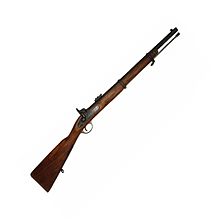Musketoon: Difference between revisions
Appearance
Content deleted Content added
Extended confirmed users 108,415 edits m it's -> its |
Rescuing 1 sources and tagging 0 as dead. #IABot (v1.6.2) |
||
| Line 16: | Line 16: | ||
<references /> |
<references /> |
||
*[http://www.nmm.ac.uk/collections/search/listResults.cfm?category=firearms&name=Musketoon&sortBy=title Musketoons] in the British [[National Maritime Museum]] online collections |
*[https://web.archive.org/web/20070930033607/http://www.nmm.ac.uk/collections/search/listResults.cfm?category=firearms&name=Musketoon&sortBy=title Musketoons] in the British [[National Maritime Museum]] online collections |
||
*[http://www.nmm.ac.uk/searchbin/searchs.pl?exhibit=it0083g&axis=1169909040&flash=&dev= Usage information] from the British National Maritime Museum |
*[http://www.nmm.ac.uk/searchbin/searchs.pl?exhibit=it0083g&axis=1169909040&flash=&dev= Usage information] from the British National Maritime Museum |
||
Revision as of 08:52, 9 February 2018

The musketoon is a shorter-barrelled version of the
pirates in particular, though they also served in a carbine role with cavalry. Musketoon barrels were often flared at the muzzle, resembling a cannon or blunderbuss
.
Description
Musketoons had a
caplock mechanism[1]
firing mechanism, like the typical musket of the period. They were fired from the shoulder like the musket, but the shorter length (barrels were as short as a foot (30 cm) long) made them easier to handle for those in restricted conditions, such as mounted infantry and naval boarding parties.

Smaller bore musketoons matched the caliber of the muskets in service, and were generally used the same way, with single musket ball or a
buckshot or pistol balls (generally smaller in diameter than musket balls) and used as shotguns. It is this type of loading that is most associated with naval use. Their resemblance to earlier weapons like the blunderbuss has led to their misidentification in both scholarly and popular media.[2][3]
Service
Due to its smaller size and weight the "
"Brown Bess" musket or Baker rifle. The British army updated their cavalry carbines in the percussion era, issuing the Enfield pattern of 1858 and the 1861 artillery or cavalry carbines
, both with 24 inch rifled barrels. Other European armies also armed their cavalry units with shorter-barreled carbines or musketoons.
Musketoons saw service with the US Army on land as the short length musket-caliber Springfield Model 1847 Musketoon. The weapons were issued to antebellum dragoons between the Mexican-American War and the American Civil War and are known to have been used at the Battle of Pine Creek,[5] and by Captain Andrew Jackson Smith's forces near Big Meadows.[1][6]
References
- ^ a b Gorenfeld, John; Gorenfeld, William (June 1998). "The Springfield musketoon was the gun that almost lost the...". Wild West. 11 (1): 10.
- .
- ^ Handy, Ryan Maye (August 5, 2011). "Walgreens repels possible second pirate boarding". Gazette, The (Colorado Springs, CO).
- ^ Traynor, Lisa. "Short Light Cavalry Carbine (Paget Carbine)". Royal Armouries. Retrieved 7 September 2017.
- doi:10.2307/20609717.
- ISBN 978-1-59884-344-6.
- Musketoons in the British National Maritime Museum online collections
- Usage information from the British National Maritime Museum
See also
- )
